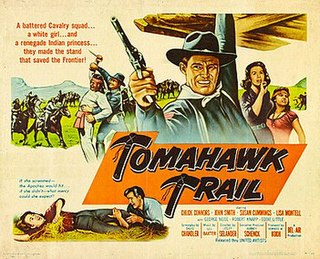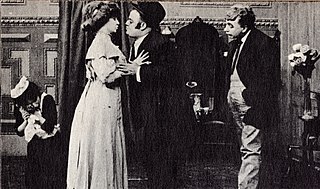Related Research Articles

The Squaw Man is a 1914 American silent Western film directed by Cecil B. DeMille and Oscar C. Apfel, and starring Dustin Farnum. It was DeMille's directorial debut and the first feature-length film to be shot in what is now Hollywood.

The English word squaw is an ethnic and sexual slur, historically used for Indigenous North American women. Contemporary use of the term, especially by non-Natives, is considered derogatory, misogynist, and racist.

Across the Wide Missouri is a 1951 American Technicolor Western film based on historian Bernard DeVoto's eponymous 1947 book. The film dramatizes an account of several fur traders and their interaction with the Native Americans.

The Prairie: A Tale (1827) is a novel by James Fenimore Cooper, the third novel written by him featuring Natty Bumppo. His fictitious frontier hero Bumppo is never called by his name, but is instead referred to as "the trapper" or "the old man". Chronologically The Prairie is the fifth and final installment of the Leatherstocking Tales, though it was published before The Pathfinder (1840) and The Deerslayer (1841). It depicts Natty in the final year of his life, still proving helpful to people in distress on the American frontier. The book frequently references characters and events from the two books previously published in the Leatherstocking Tales as well as the two which Cooper would not write for more than ten years. Continuity with The Last of the Mohicans is indicated by the appearance of the grandson of Duncan and Alice Heyward, as well as the noble Pawnee chief Hard Heart, whose name is English for the French nickname for the Delaware, le Coeur-dur.

The Mountain Men is a 1980 American adventure Western film directed by Richard Lang and starring Charlton Heston and Brian Keith. Heston's son, Fraser Clarke Heston, wrote the screenplay.
Anthony O'Sullivan was an American silent film actor and film director. He appeared in more than 160 films between 1906 and 1918. He also directed 35 films between 1913 and 1915. He died in The Bronx, New York

Stanner E.V. Taylor was an American screenwriter and film director of the silent era. He wrote for more than 100 films between 1908 and 1929.

John T. Dillon was an American actor of the silent era. He appeared in more than 130 films between 1908 and 1936. He died in Los Angeles, California from pneumonia.
His Trust Fulfilled is a 1911 American drama film directed by D. W. Griffith. It is a sequel to His Trust. Prints of this film survive in the film archives of the Library of Congress and the Museum of Modern Art.

The Lonedale Operator is a 1911 short American drama film directed by D. W. Griffith, starring Blanche Sweet and written by Mack Sennett for the Biograph Company. The plot of the film involves a girl who takes over a telegraph station after her father takes ill. After the payroll for the town's mine is delivered, two drifters try to steal the money. Their robbery is foiled because the girl is able to telegraph for help and then hold the would-be robbers off until help arrives. The Lonedale Operator includes "elements of romance, drama, suspense, Western, and even a bit of comedy near the end."

James Young Deer, also known as J. Younger Johnson or Jim Young Deer, was actually born James Young Johnson in Washington, D.C. Although he was identified in the early Hollywood trade paper Moving Picture World as of the Winnebago Tribe of Nebraska, his ancestry is of the Nanticoke people of Delaware. He became an early film actor, director, writer, and producer. He is believed to be the first Native American filmmaker/producer in Hollywood. Together with his wife and partner Lillian St. Cyr, Winnebago, the couple were labeled an "influential force" in the production of one-reel Westerns during the first part of the silent film era. Their films, along with several others of the silent era, were notable for portraying Native Americans in a positive light.

The Last Drop of Water is a 1911 American short silent Western film directed by D. W. Griffith and starring Blanche Sweet. Three known prints of the film survive. It was filmed in the San Fernando desert as well as Lookout Mountain, California. The film was considered the "most ambitious film made by Griffith during the California trip of 1911" before the Biograph company moved back to New York. It was filmed on or between the 14 May and May 20, 1911. It was reissued by Biograph August 13, 1915.

The Italian Barber is a 1911 short silent drama film directed by D. W. Griffith, starring Joseph Graybill and featuring Mary Pickford. The film, by the Biograph Company, was shot in Fort Lee, New Jersey when many early film studios in America's first motion picture industry were based there at the beginning of the 20th century.

Tomahawk Trail is a 1957 American Western film directed by Lesley Selander and starring Chuck Connors.

Red Wing was an American actress of the silent era. She and her husband James Young Deer have been dubbed by some as one of the first Native American Hollywood "power couple(s)" along with Mona Darkfeather and her actor/director husband Frank E. Montgomery. St. Cyr was born on the Winnebago Reservation in Nebraska.

Mrs. Jones Entertains is a 1909 American silent short comedy film directed by D. W. Griffith. The Internet Movie Database lists Mary Pickford as appearing in this short. However, Pickford did not begin with Biograph until the end of April 1909.

Charles Earl Bartlett was an American silent film director.

The Champion Film Company was an independent production company founded in 1909 by Mark M. Dintenfass. The studio was one of the film companies that merged to form Universal Pictures.

Fisher Folks is a 1911 silent film short directed by D. W. Griffith. It was produced and released by the Biograph Company. It is one of several films written for Griffith by journalist Harriet Quimby soon before she gained fame as a pioneering aviator.

Bison Film Company, also known as 101 Bison Film Company, is an American film studio established in 1909 and disestablished in 1917.
References
- ↑ Österberg, Bertil O. (15 April 2009). Colonial America on Film and Television: A Filmography. McFarland Publishing. p. 193. ISBN 9780786442423.
- ↑ Lowe, Denise (27 January 2014). An Encyclopedic Dictionary of Women in Early American Films: 1895-1930. Routledge. p. 1939. ISBN 9781317718970.
- ↑ Stokes, Melvyn (15 January 2008). D.W. Griffith's the Birth of a Nation: A History of the Most Controversial Motion Picture of All Time. Oxford University Press. p. 351. ISBN 9780199887514.
- ↑ Usai, Paolo Cherchi; Bowser, Eileen (26 November 2000). The Griffith Project: Films produced in 1910. British Film Institute. p. 170. ISBN 9780851708058.
- ↑ Bernardi, Daniel; Green, Michael (7 July 2017). Race in American Film: Voices and Visions that Shaped a Nation. ABC-CLIO. p. 384. ISBN 9780313398407.
- ↑ Drew, William M. (1986). D.W. Griffith's Intolerance: Its Genesis and Its Vision. McFarland & Company Incorporated Pub. p. 7. ISBN 9780899501710.